Inside An Amish Schoolhouse (21 Photos)
I want to share a set of photos with you today taken by Don Burke in an Amish schoolhouse in Missouri. This great set of shots shows a lot of detail inside a school in a fairly progressive Amish community.
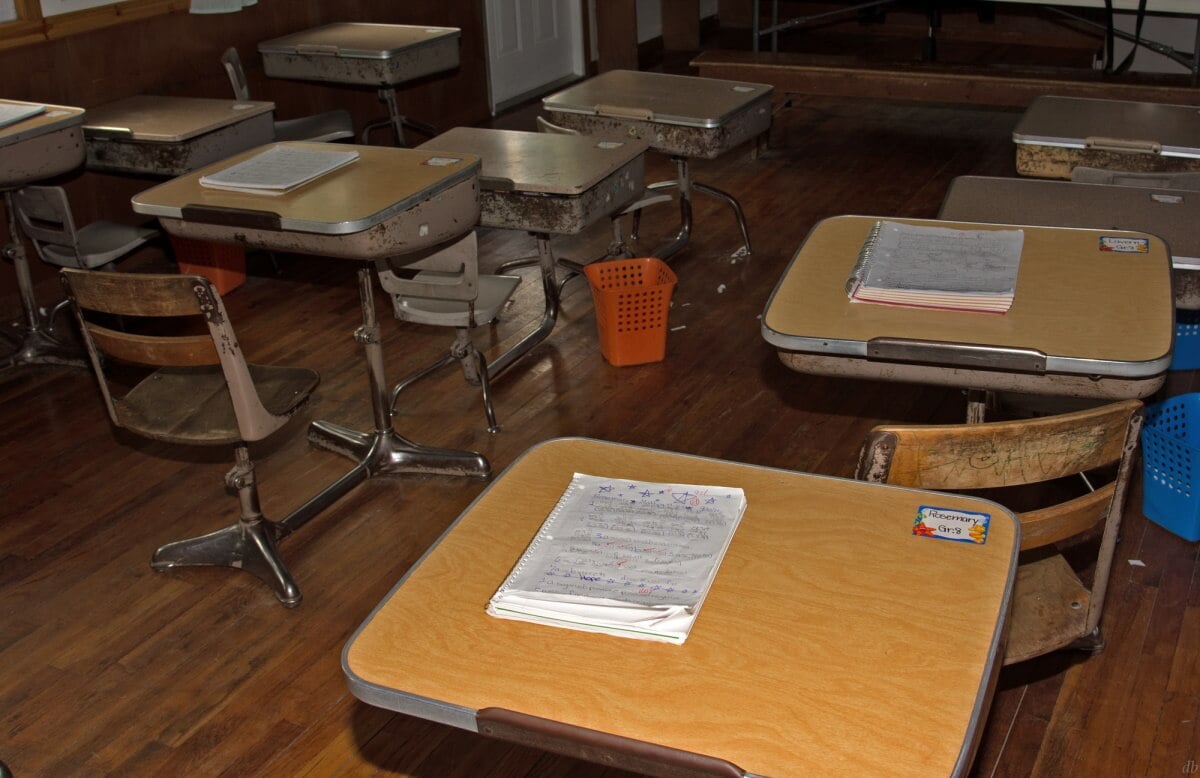
Even though I describe the community as “fairly progressive”, much of what you’ll see here has a quite old-fashioned look about it. Amish schools tend to be that way. And I have to say some of it reminds me of my own elementary school experience in the 1980s.
Now, I went to a school in the city, not a one-room schoolhouse. But still a lot of this felt familiar to me given the era. Maybe you’ll feel the same. So let’s have a look inside.
Inside the School
Here’s a wide shot showing the classroom. Amish schools typically stay a relatively small size, around 20-30 pupils (aka “scholars”). They can be larger or smaller than that. Amish will build new schoolhouses as the community grows. Being able to get to one easily is important as children will walk, scooter, bike, or take a pony cart.
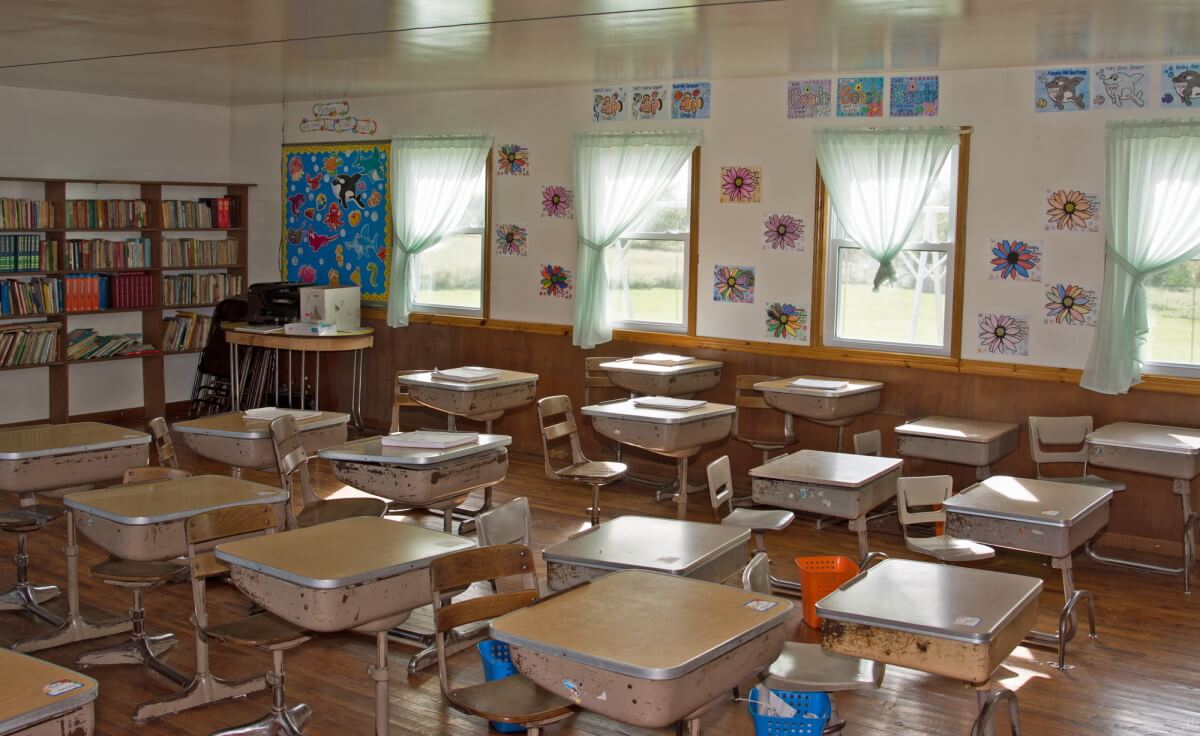
Here’s a closer look at the bookshelves in the back of the room. Among the selections are a set of World Book encyclopedias and a Childcraft set.
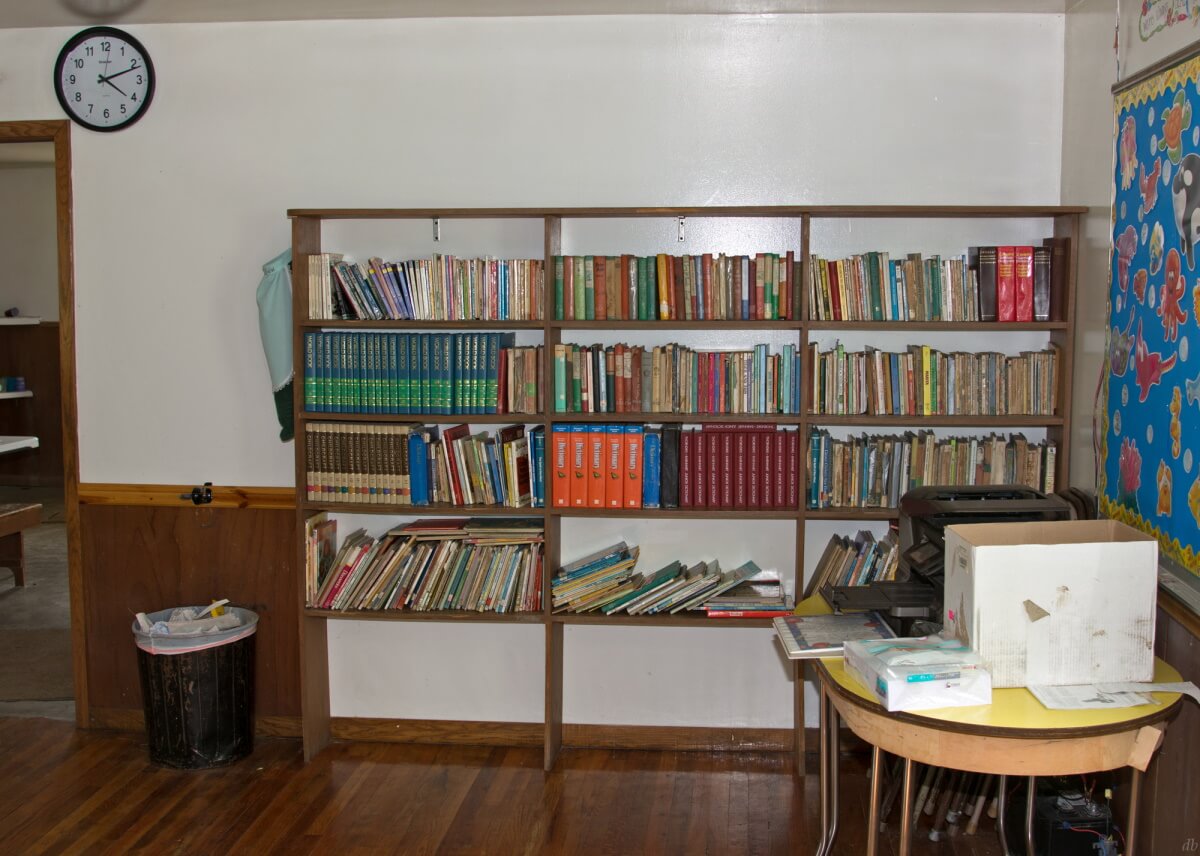
Another angle showing the colorful artwork and many windows letting light flood into the schoolhouse. A cheery place.
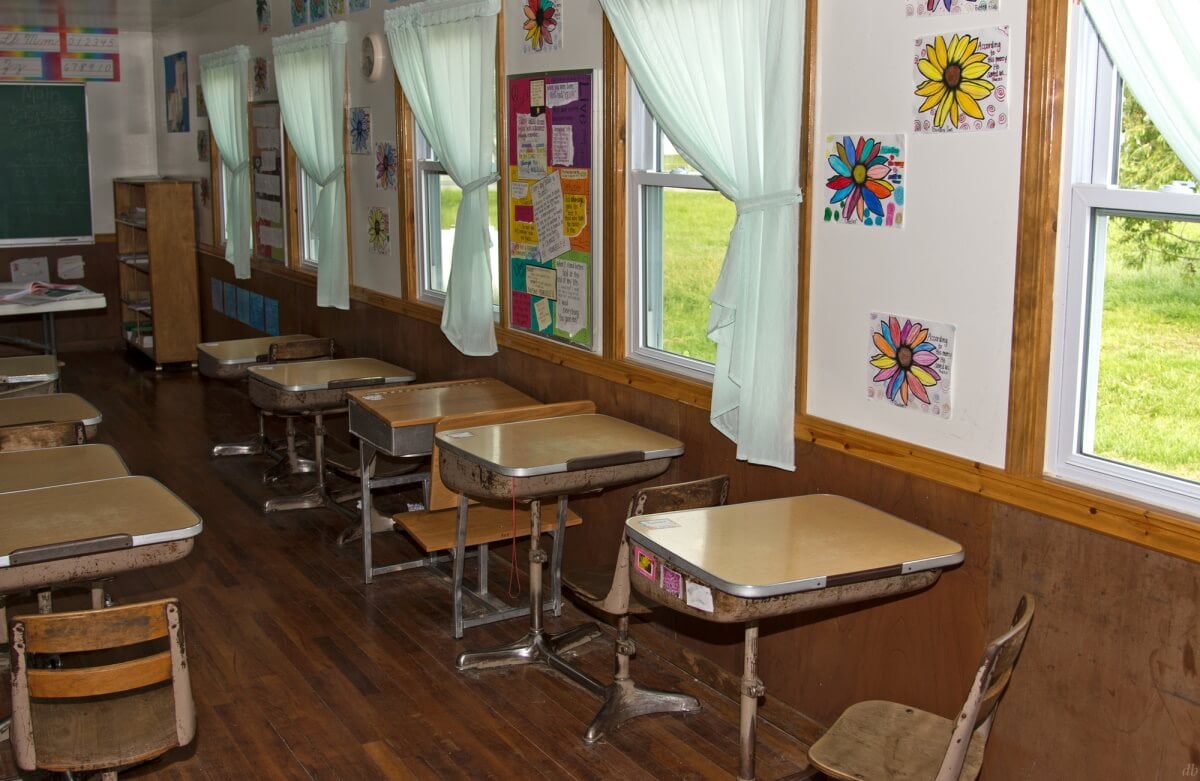
Other books and materials. I can’t say for sure but on the upper left those might be individual scholars’ grade records. Or maybe not, there might be too many of them. A Bible rests on the top shelf.
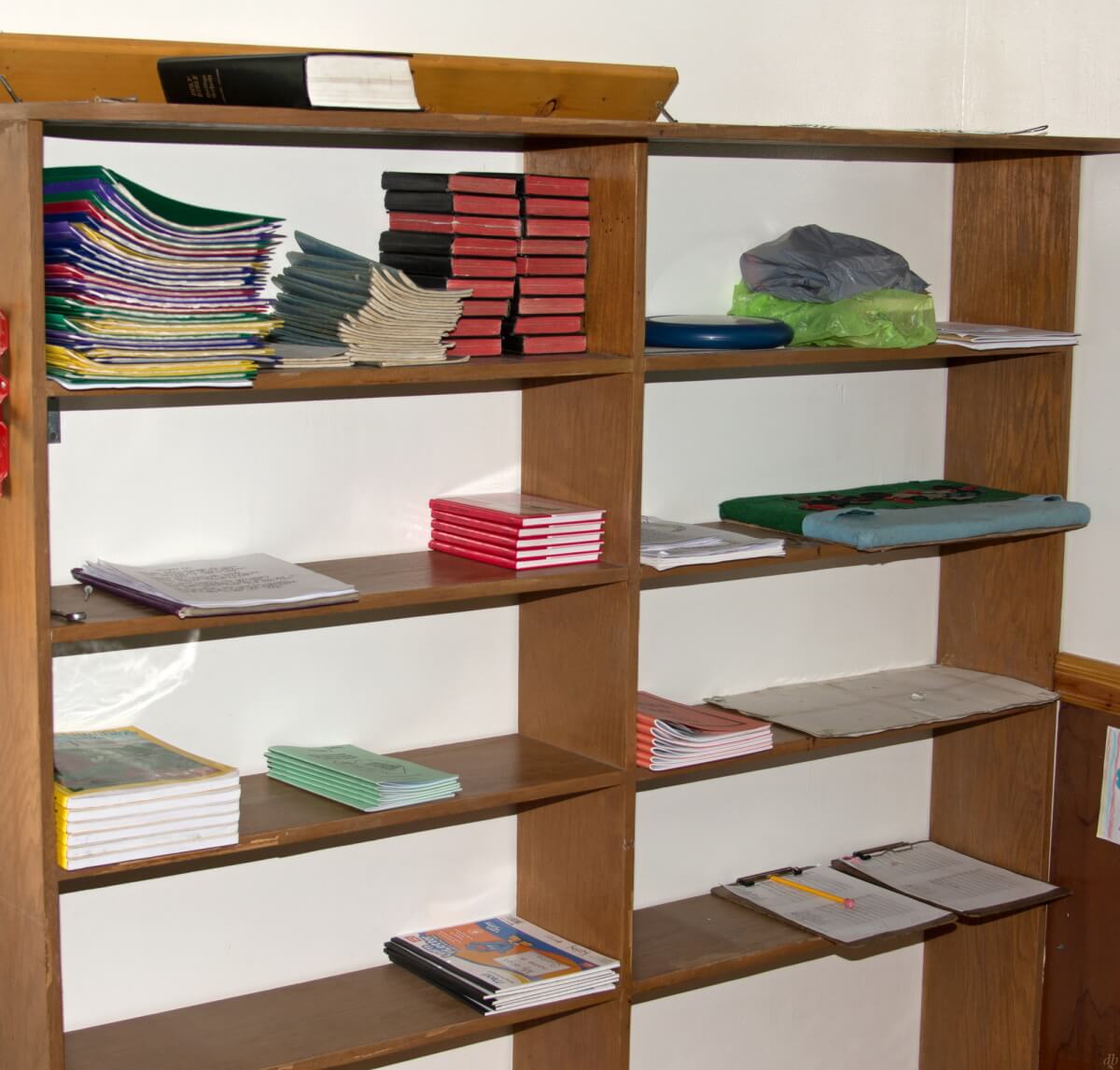
Looking on the opposite side of the room, we can catch a partial glimpse of the teacher at her desk.
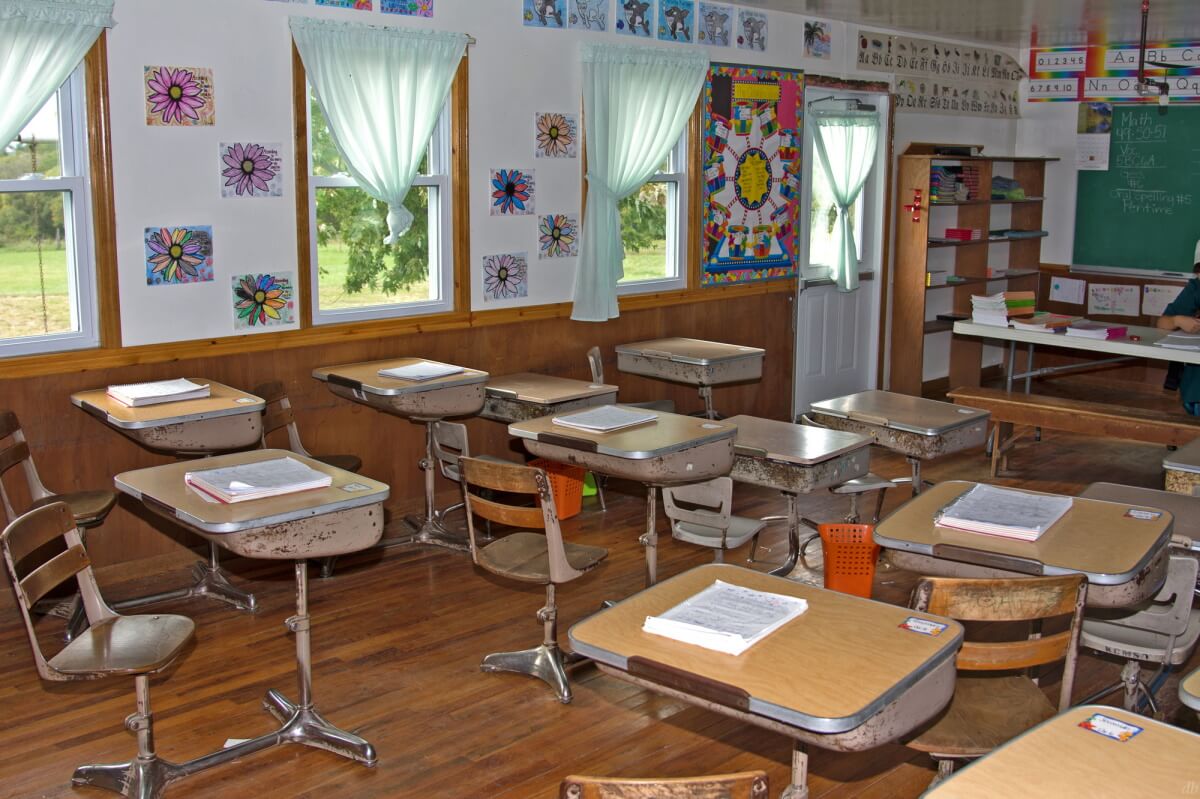
So this might come as a surprise to some, but here you have a dividing curtain. What is that for? Well, in some Amish schools they will split the group into grades 1-4 and 5-8. Two teachers or a teacher and assistant will handle the groups separately.
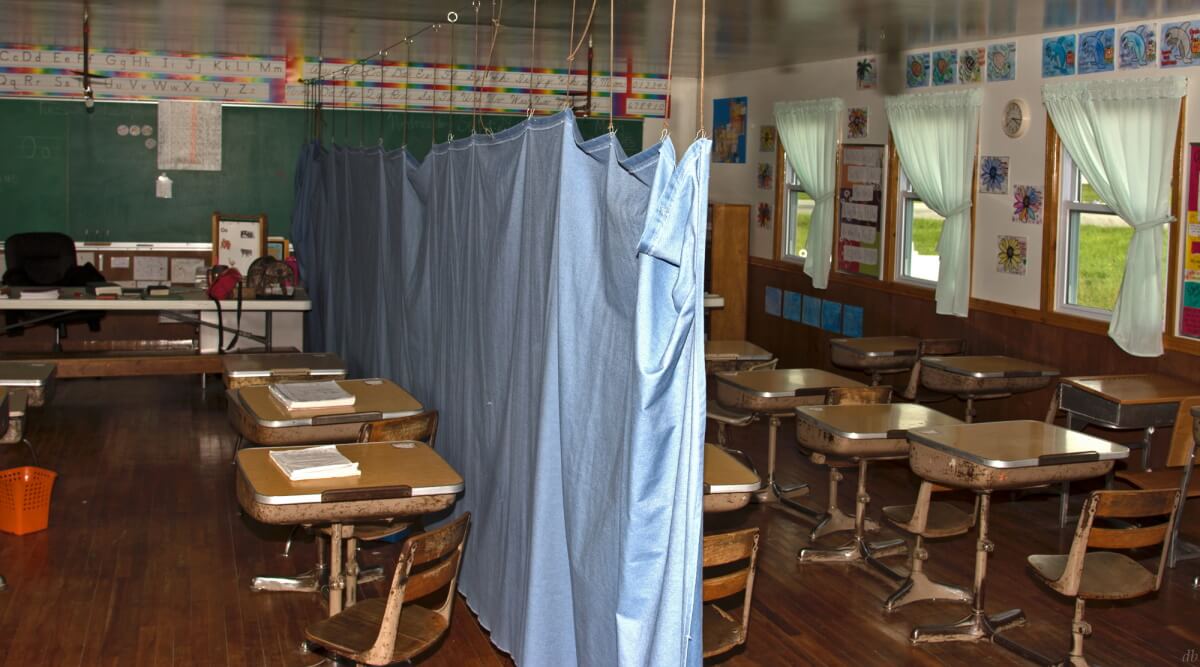
Here we see a German alphabet. School is where Amish children learn High German, their third language after Pennsylvania Dutch and English.
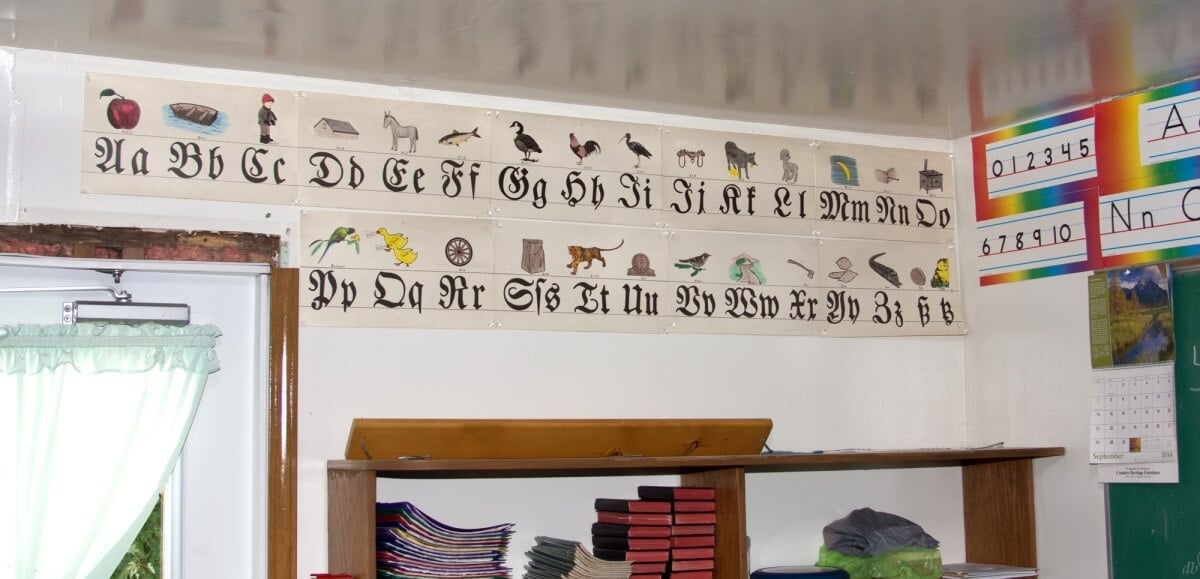
These desks remind me of ones I sat at in my earlier elementary years. The one-piece metal design is quite familiar, though the ones I remember were a somewhat different model. You can see these have been around awhile. They may not be the most beautiful to look at, but they remain functional and are put to good use in this Amish school.

Looking towards the back of the room we can notice a filing cabinet and heat source.
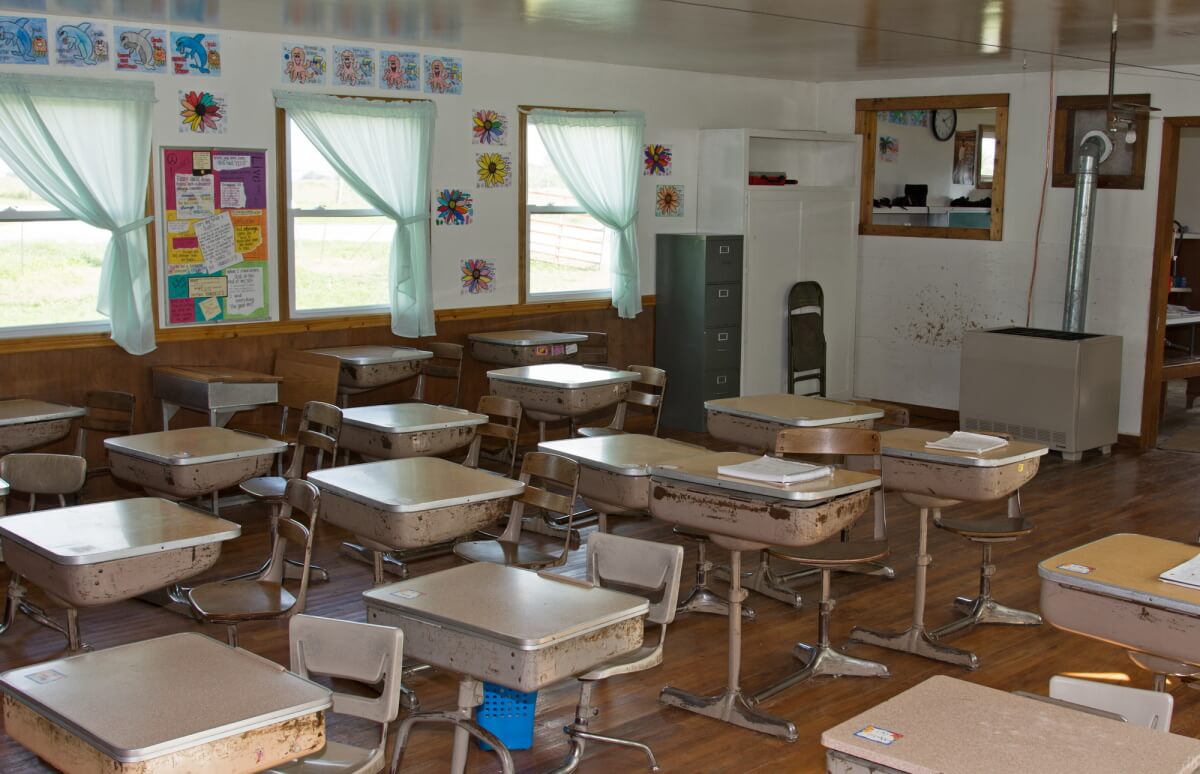
“The Cleaning Wheel.” A nice way to dole out school maintenance tasks. Among the tasks we have “Sweepers”, “Clean Blackboard”, “Wash Glasses & Clean Sink”, “Move Desks”, and…toilet duty. One of the many ways Amish children learn humility?
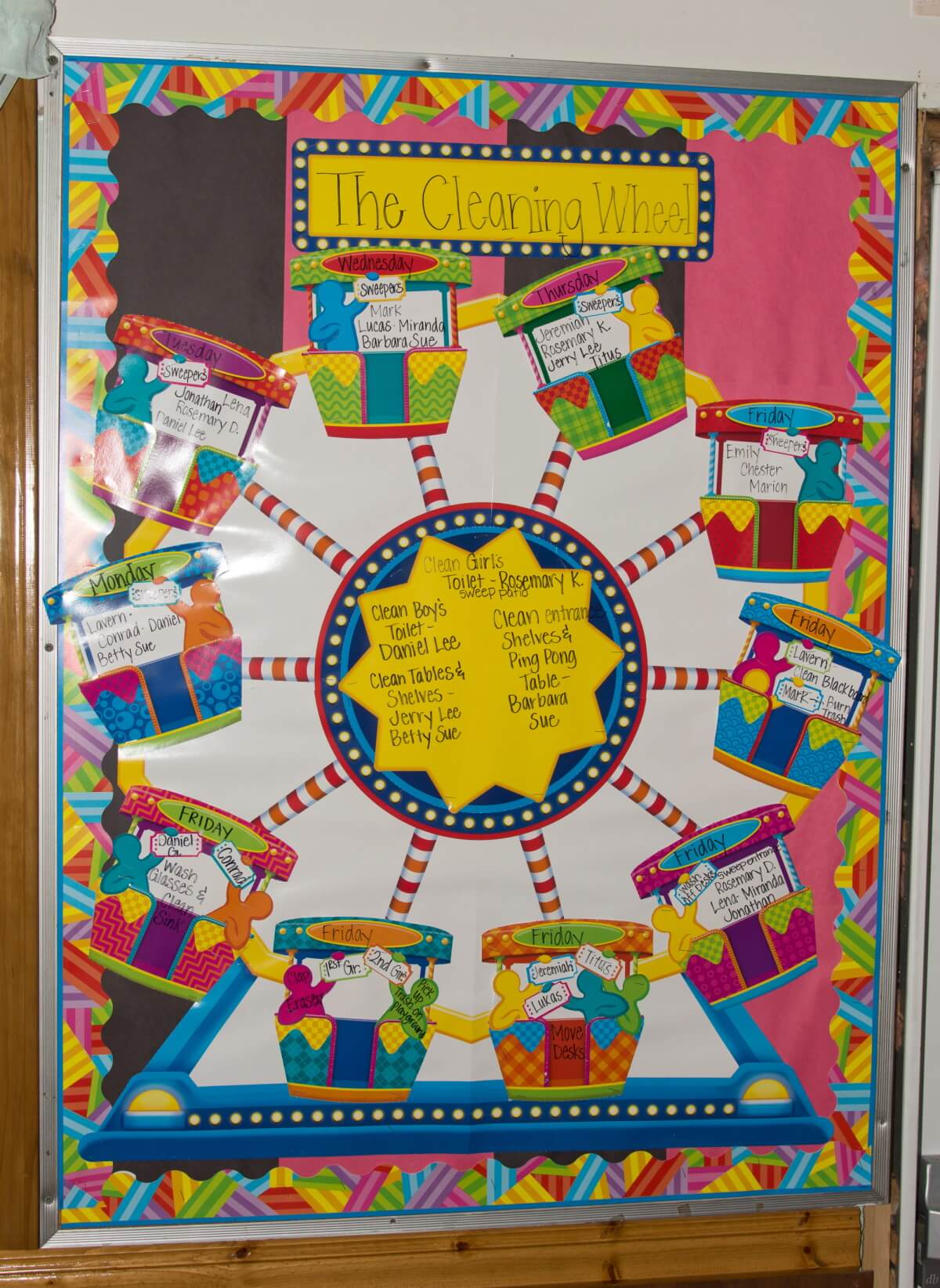
Teacher’s Area
Having a look at the teacher’s area, or rather the teachers’ areas. Here you can see the dividing curtain fully pulled back and teachers’ desks on both sides.
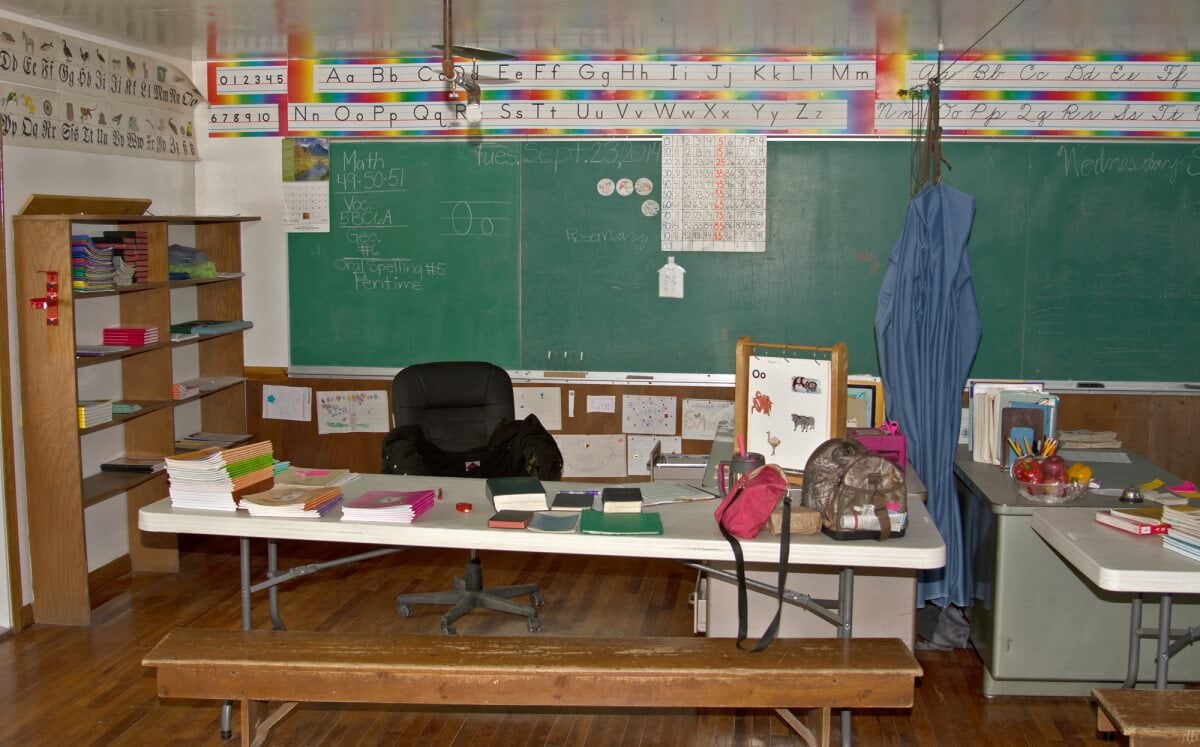
The blackboard (or is it “greenboard”?). I wrote on these with old-fashioned chalk (and I cringe just thinking about it) until in later years we made use of dry erase boards. Do non-Amish children still use black/greenboards and chalk?
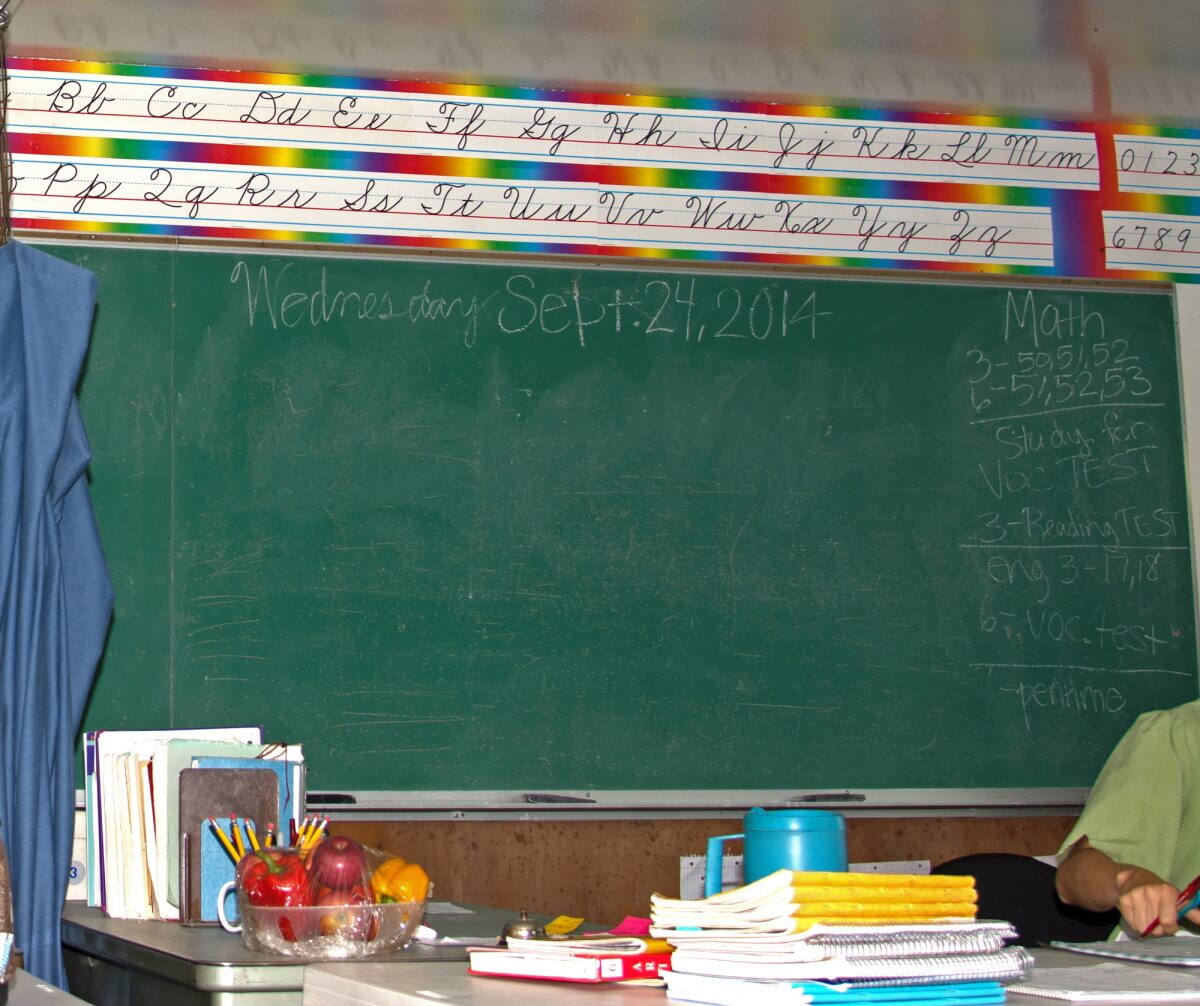
Amish schools do not have formal religious instruction, but they do have Bible readings and prayer, and sing religious songs in schools.
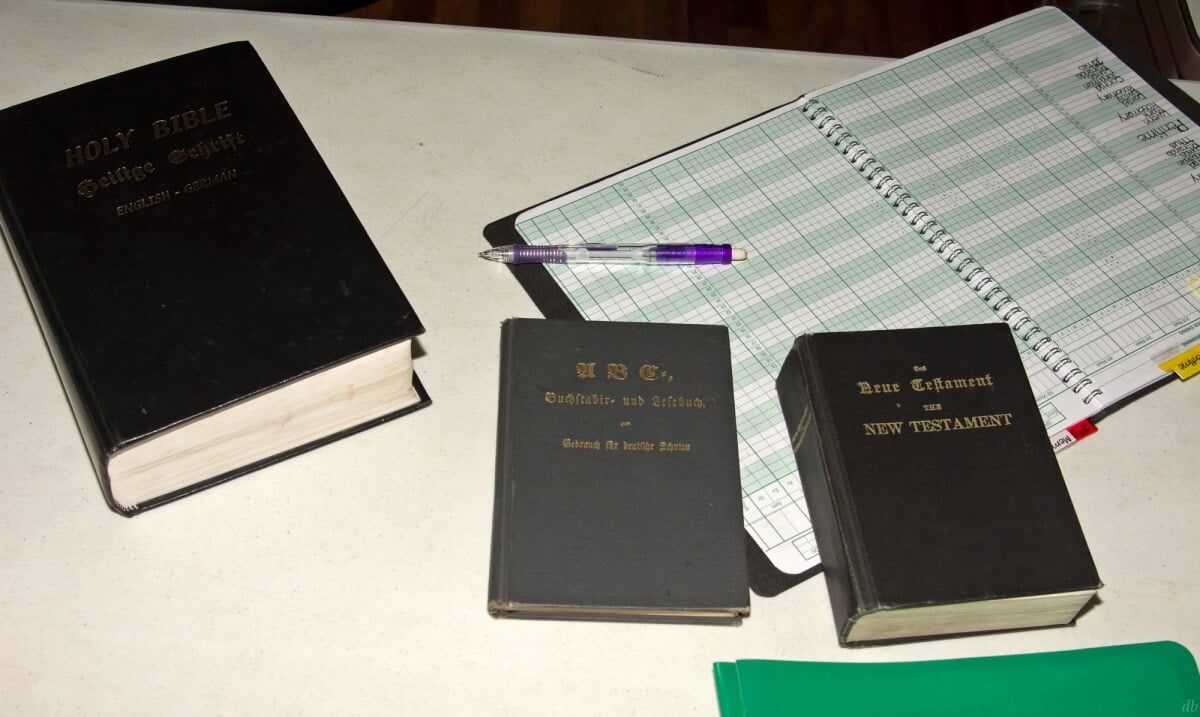
Recreational Activities
Softball is perhaps the most common game played in Amish schools. Scholars’ mitts and hooks with names for hanging garments.
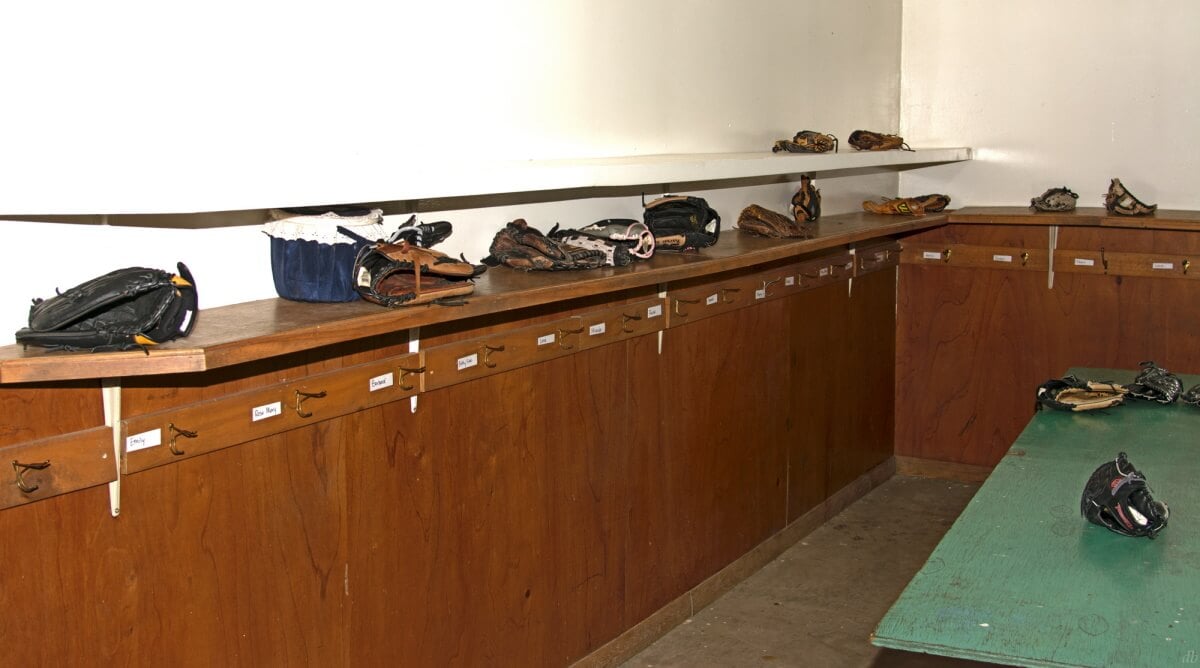
In the corner you’ll notice a box with bats.
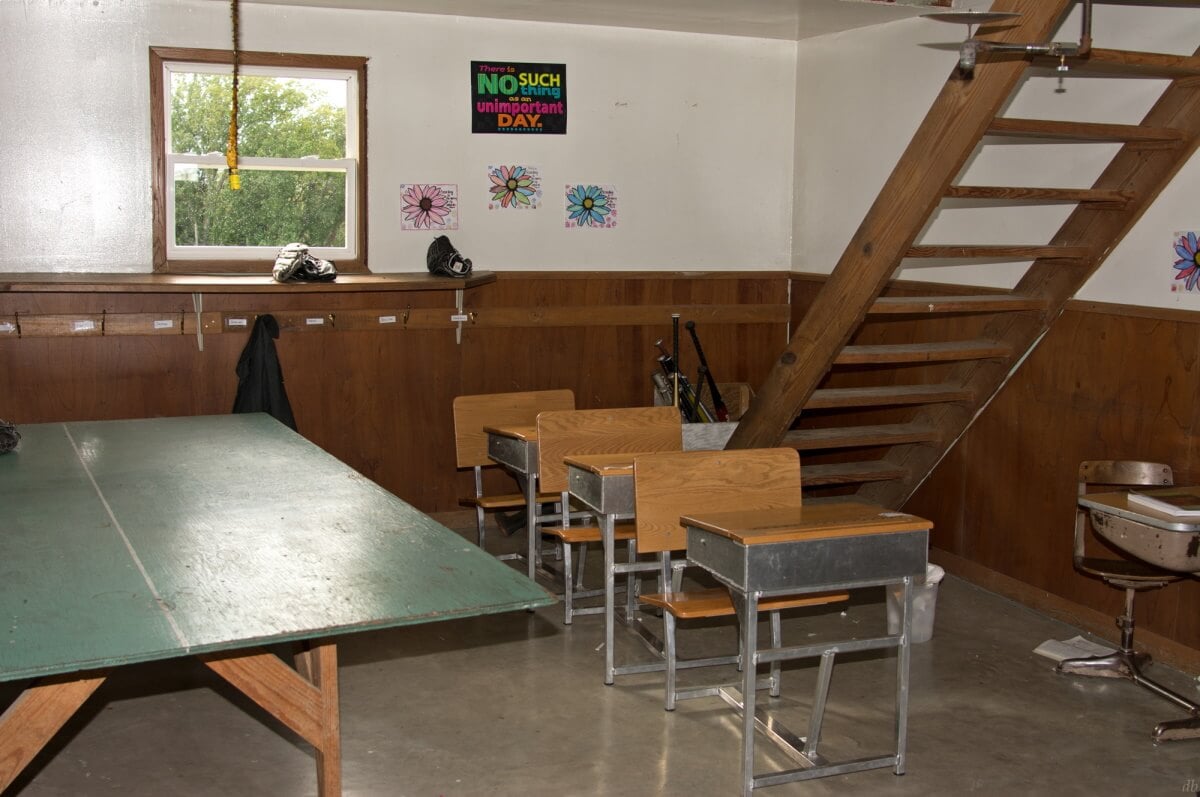
And a look at the batter’s box from the third-base perspective. That might be an outhouse behind the backstop.
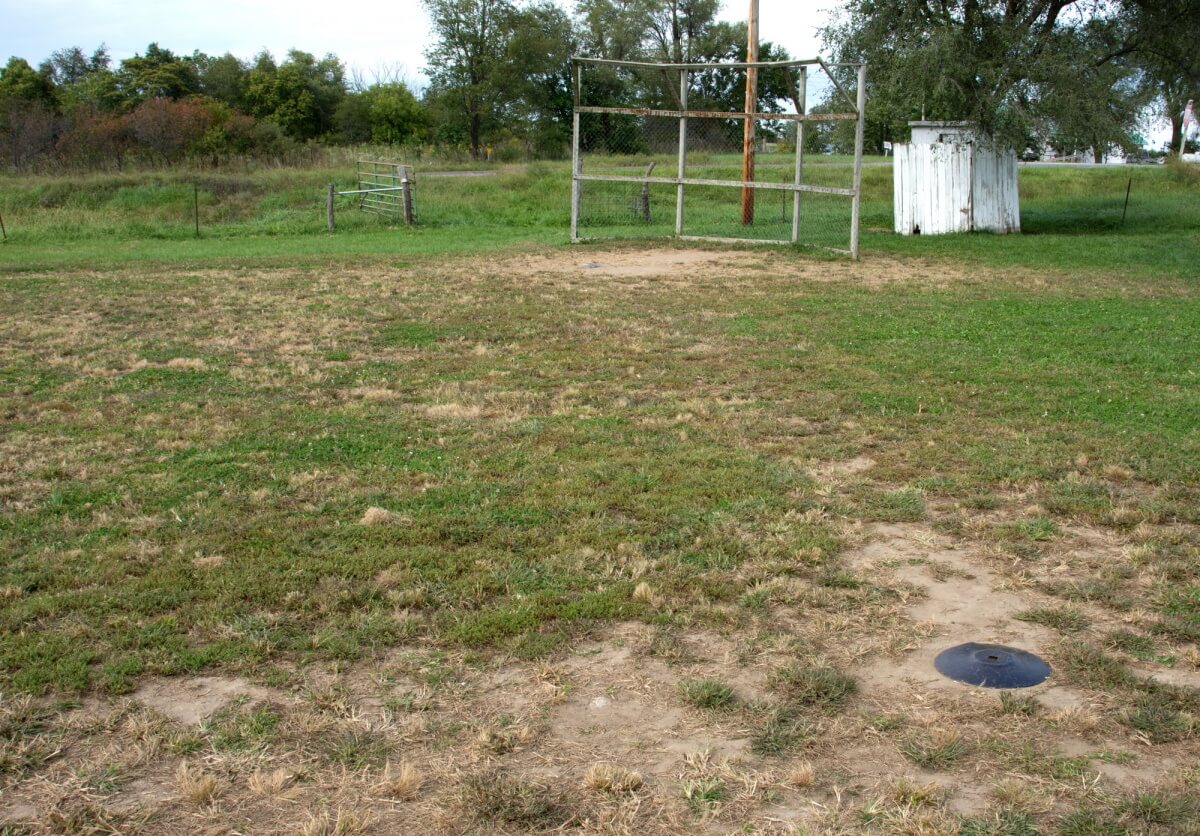
And here we see the playground area with swings and see-saws (or teeter-totters, I guess depending on where you’re from).
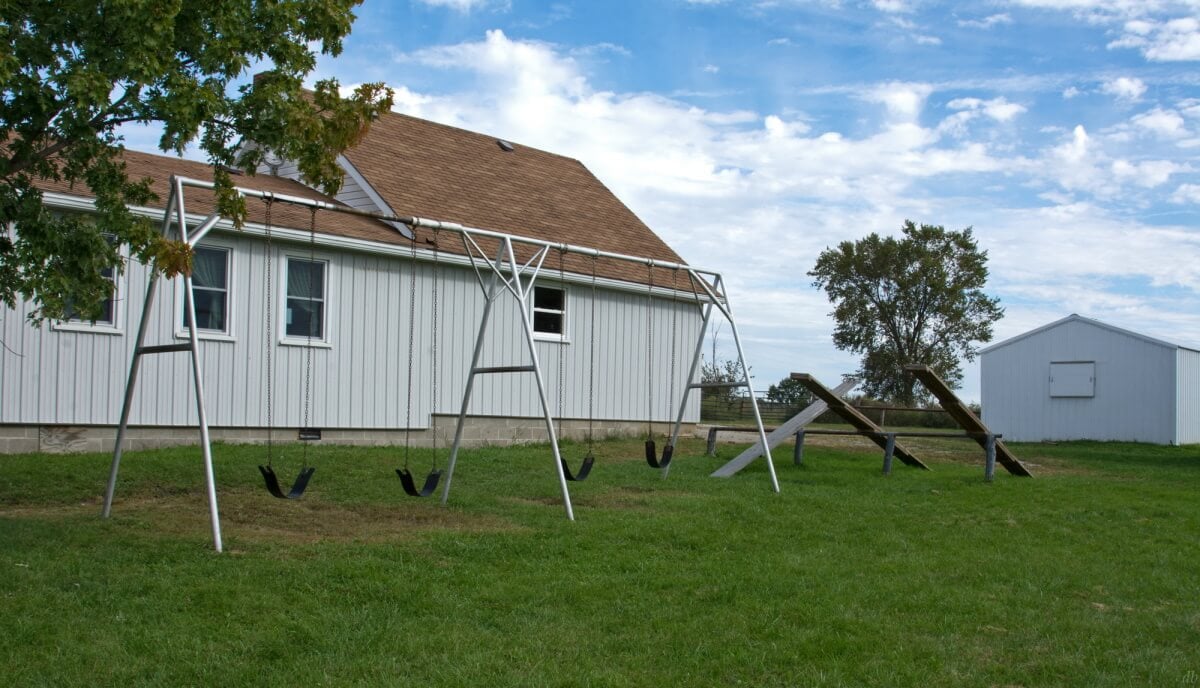
During my most recent visit to an Amish schoolhouse (December), I joined in a game of soccer. This is more popular in colder weather in Lancaster County schools, though softball and other games remain popular as well. I don’t know how much soccer has taken off in other communities.
School Amenities
Finally, let’s have a look at some of the school’s amenities. For dark mornings and winter months, this gas mantle light will add extra illumination to that provided by the numerous windows.
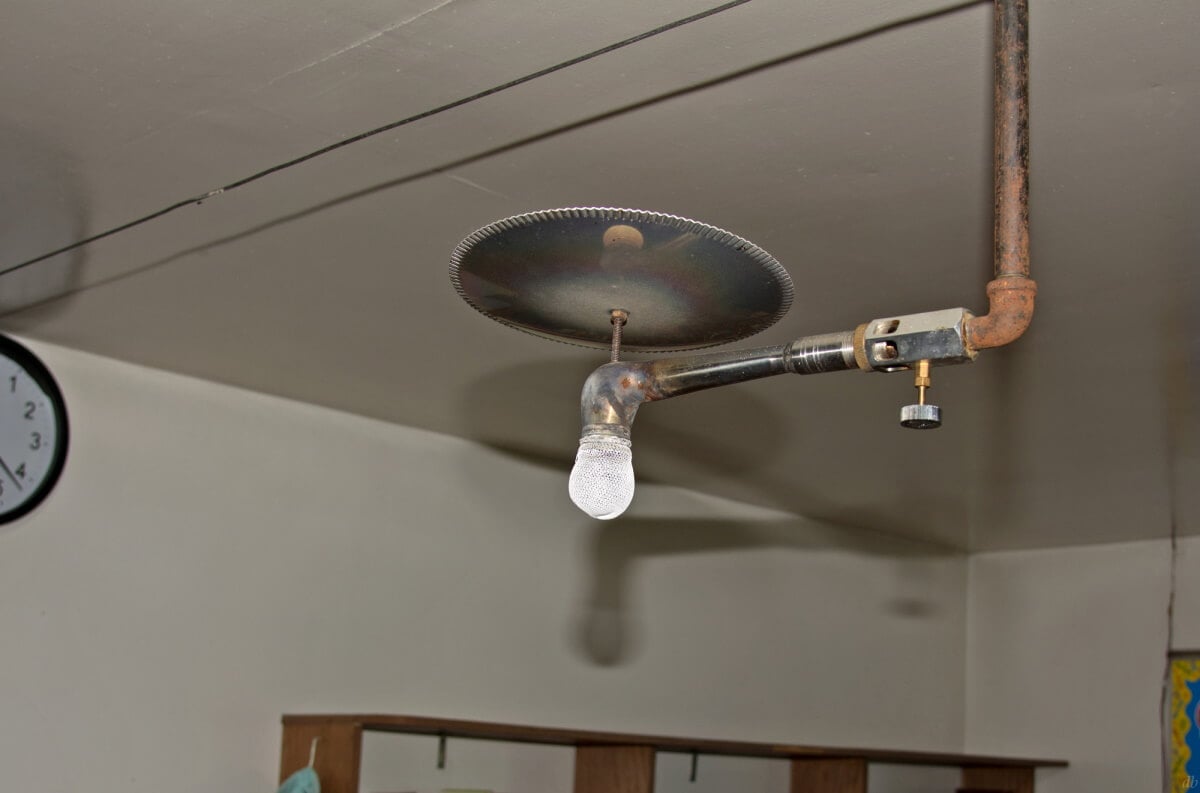
And a closer look at the heating. Right around the corner you will see a fire extinguisher. And beyond that it appears to be another partial glimpse of a teacher. This may be an area for teaching children with special needs, though I’m only speculating.
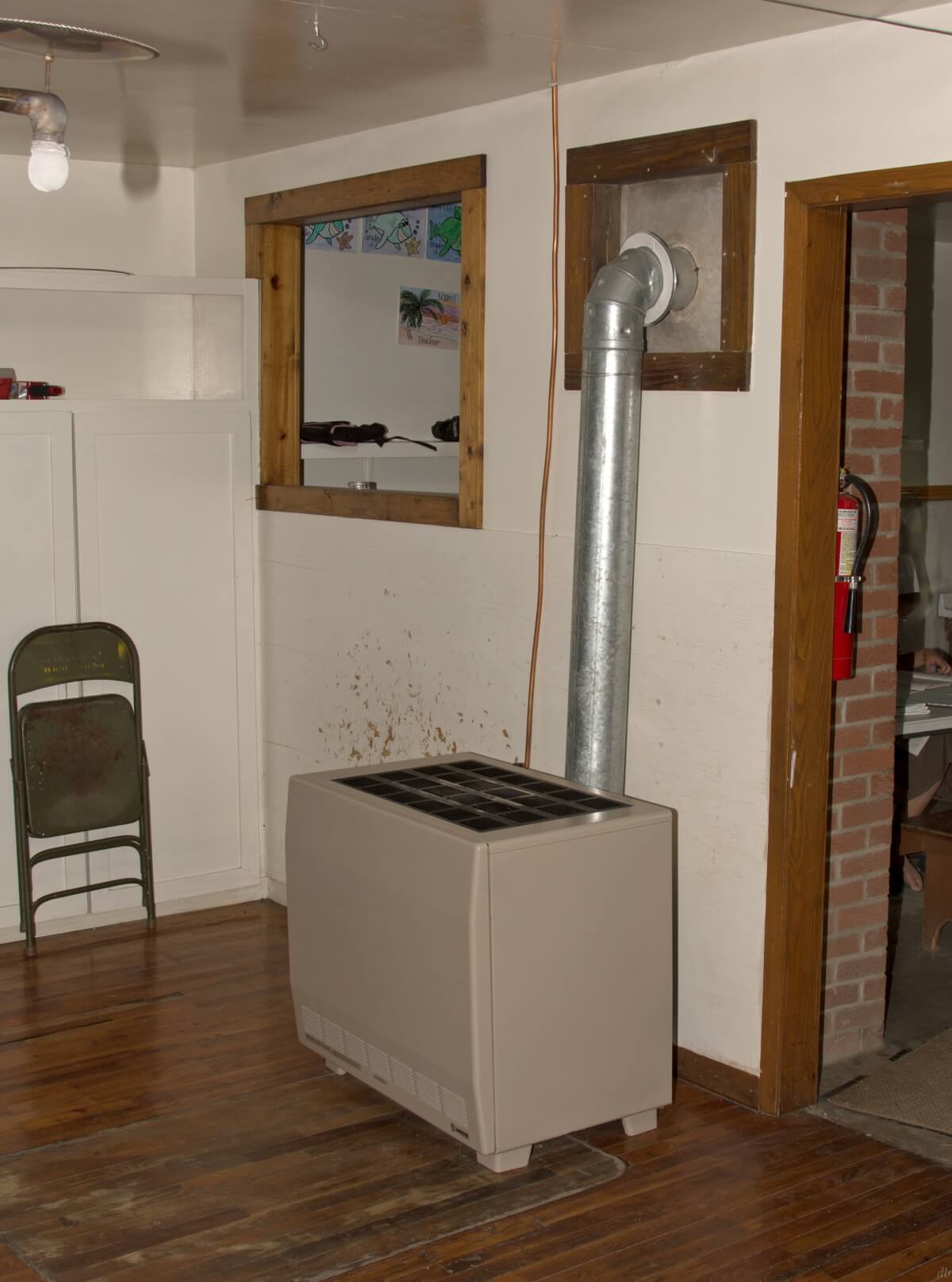
So this is likely the highest-tech piece of equipment in the school. Amish schools in more progressive communities will have copy machines/printers to produce handouts and the like. Note power source at bottom left.
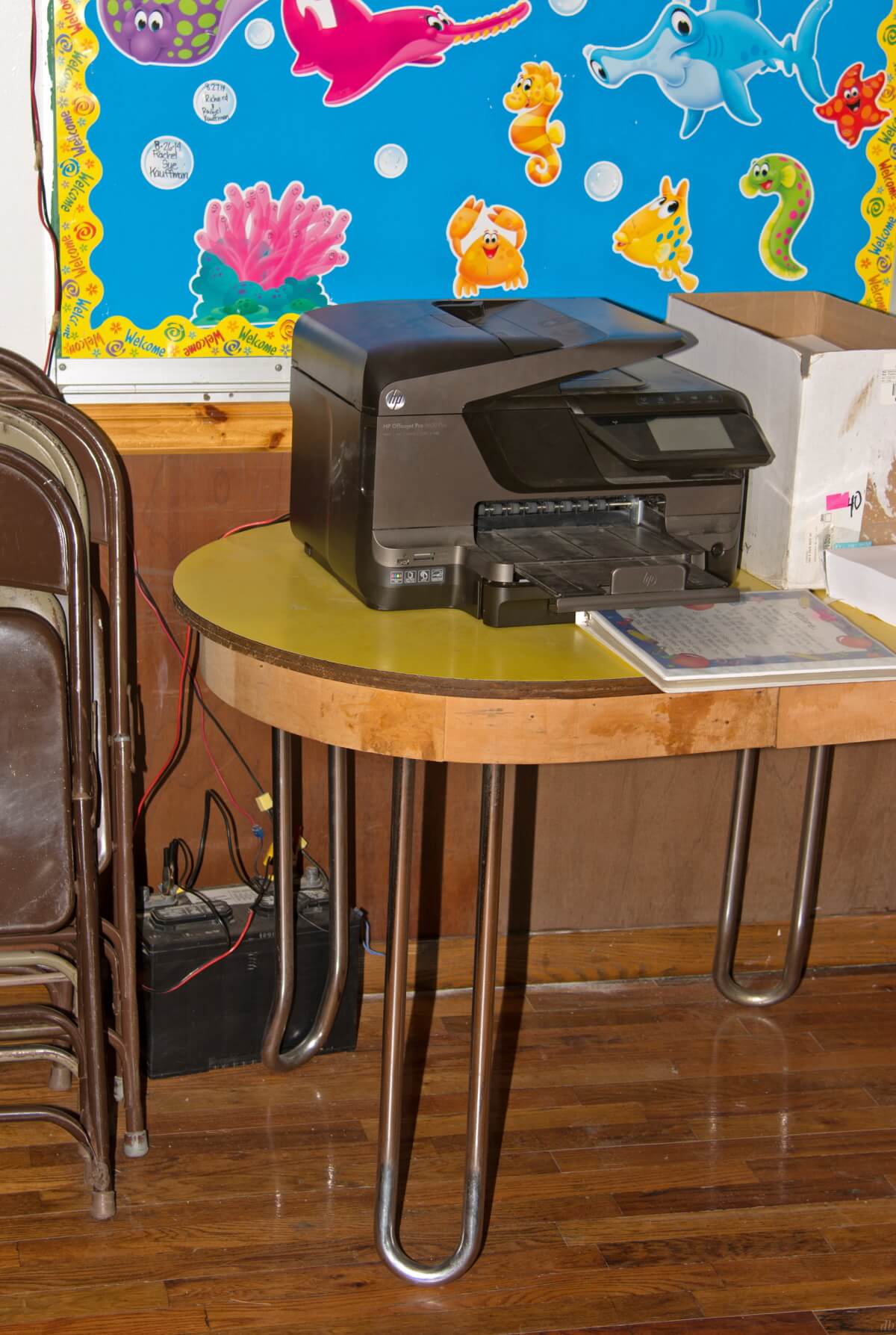
And last but not least, a sink with water source. You can see the children’s cups, each with a name written on the bottom or side. Cleaning this area up is someone’s job, according to the “Cleaning Wheel.”
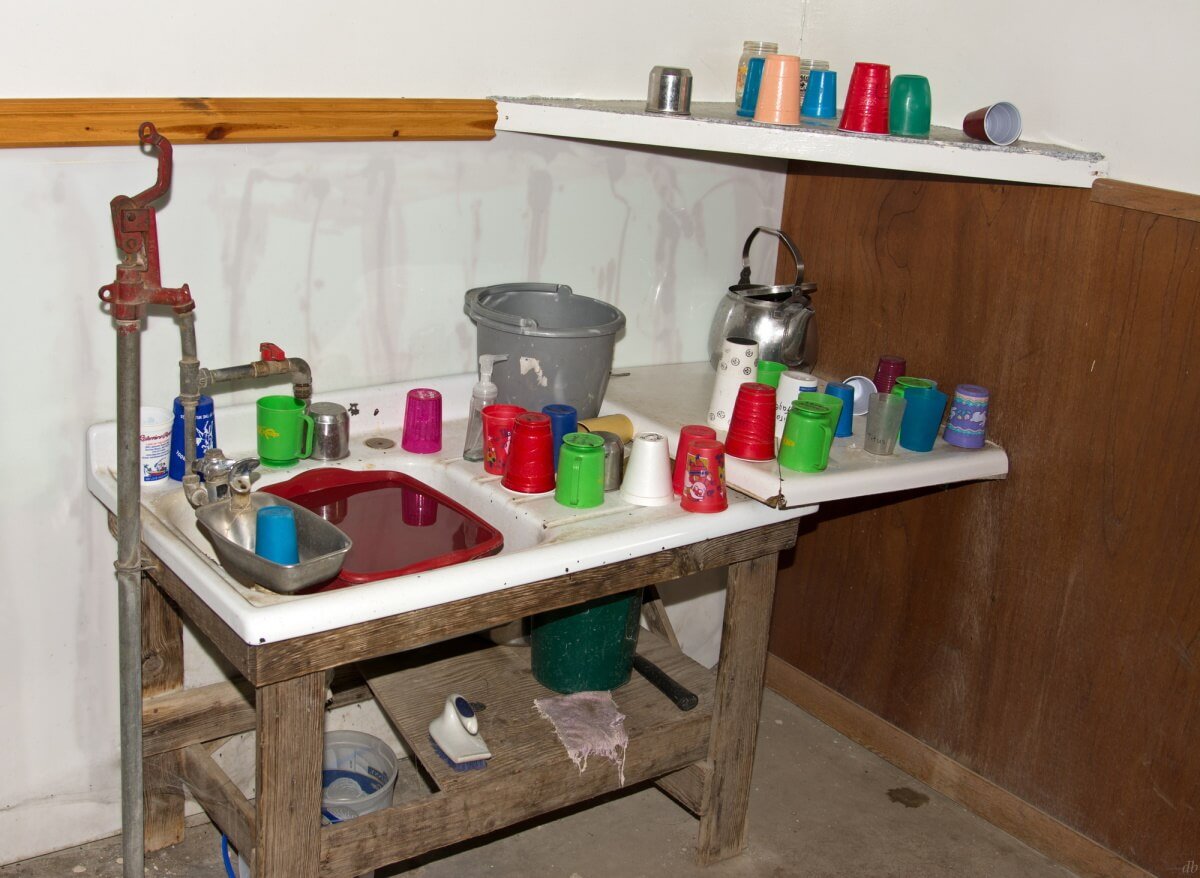
I hope you enjoyed that look inside an Amish school. Did anything here remind you of your own school experience?
More on Amish schools:
15 Ways Amish Schools Differ From Public Schools
5 Things Amish Children Learn In School (Besides Book Subjects)



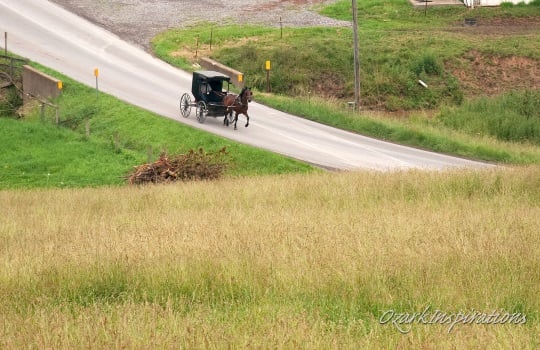
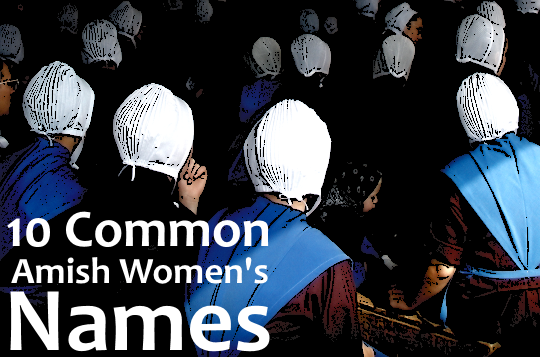
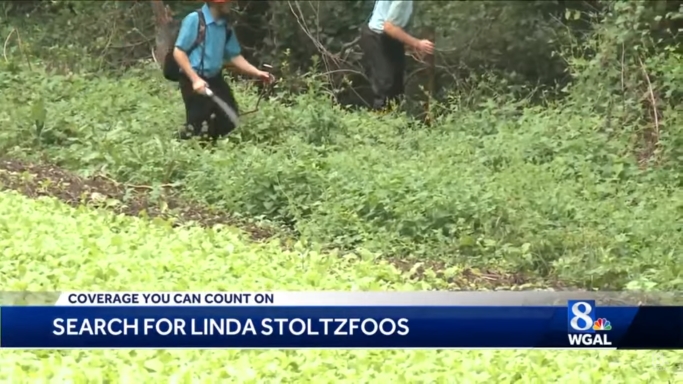
Very similar to my school during the 1970's
I went to a small local school in the 1970’s and this is quite familiar. I’m happy to say that schoolhouse is still operating as an independent school teaching cursive writing, gardening, and other practical skills
I wonder how many schools still teach cursive today.
Adorable
I love this little school and actually, it reminds me of a small grammar school I attended in the 1960s–same desks, but this classroom has pretty curtains, which we did not have! Looks like a fun place to learn.
It does, doesn’t it.
Amish School
The pictures look more modern that the Amish schools where I taught in Lancaster County in the 80’s. The desks had the seat of one attached to the desk of the one behind. There were no curtains but there were pull down blinds. There were floor to ceiling cupboards on each side in the back corners and this is where the children put their lunch boxes. Both schools had pumps outside for water and at Hollow School, the older boys filled a large cooler at the neighboring farm and brought it in a wagon.
This was a wonderful experience for an English teacher. Before we moved to Arkansas, one of the scholars, now a father , had a going away party and all the families were represented either by the children or thr parents.
I also recall seeing that desk-attached-to-desk layout. I might have even sat in one like that but the memory of six and seven-year-old me gets a little fuzzy.
What a great and memorable experience that must have been.
What I see...
As a teacher, I see much to appreciate and admire! During the past year, I’ve also had an opportunity to connect with a first-year Amish school teacher. One of the things I see is a true passion for learning–based on needed knowledge and not on social engineering. Yes, I was reminded of my own schooling many years ago. Education was not a commodity–it was a process that involved all stakeholders as a community. The desks also look familiar. We didn’t have a cleaning wheel as such, but we all shared (and learned) responsibility while learning to work together and support each other. We didn’t get everything perfect, and neither do the Amish. But there were aspects of our education that are sorely missing from today’s schools.
I actually saw a comment on social media regarding Amish schools suggesting somebody should report the Amish to the State Department of Education for child abuse because they are “denying those children a proper education.” In these photos, I see proof that the Amish know a lot more about how to make education work than any State DOE. There’s a lot of effective learning going on in those classrooms, and there is much to learn by looking at and into them.
Re: your second paragraph, An Amish parent might also wonder about non-Amish parents exposing their children to everything on the internet, allowing them to play (often violent) video games at home, exposing them to social media with all the negatives that can have for young minds, etc.
I don’t think either scenario is actually “child abuse”. Just different approaches reflecting their respective community’s values. Each with drawbacks as well as positives.
Thanks, Don Burke, for sharing these pictures which I enjoyed. In our rural farming neighborhood we had a one-room school, very similar to this one, until 1957. I missed attending it by two years and always regretted that.
The picture with the curtain drawn to make two classrooms reminds me of our country church’s Sunday School for religious education before the morning worship service. We had an “opening assembly” in the center of our church basement which all of the children, early teenagers and the Sunday School teachers attended. After the assembly program, several curtains made out of white sheets that were hanging on wooden poles were pulled out to make five “classrooms” in the same area. We then had our individual class sessions.
You probably are aware Al that sometimes they also sometimes have a second room. I do wonder how distracting it might be as a young scholar hearing the other class behind the curtain. But clearly it works. Five classrooms even more so but I guess that worked fine as well.
Advantages
How nice not to have to take a long bus ride to get to school, not to have to change classes or have different teachers rotating throughout the day all in a hurry. How nice to learn and help others learn in others of various ages, and to be in school with one’s siblings and friends – not being separated into different classrooms and age groups year to year.
It’s also a practice in Japan for students to clean the school building. Students know they are making a useful contribution; and are less likely to treat the building and furniture badly when they are stakeholders.
Interesting and somehow unsurprising to learn about the similar Japanese example.
Special Needs
Interesting to consider how special needs students are served. It is rare that private schools serve special needs because the cost of resources and staff needed is generally prohibitive without government funding.
These are great pictures! I love that you were able to get in there, Don. I have lots of Amish school pictures (if I can find them) but they’re only from the outside looking in. It was when school wasn’t in session and the curtains weren’t drawn, so we were able to look in the windows and see how things were. Is this near Jamesport, by any chance?
Beth, please forgive my oversight — I failed to notice this post even being made in the first place, so was totally unaware of your question to me. But yes, the school is near Jamesport, MO.
Advice to people who want to study Anabaptism more deeply
I tried to post this comment a YouTube but the lenghth there is limited, therefore I try it here, it may be of general concern:
To start I recommend Wikipedia and amishamerica.com which also has the YouTube channel https://www.youtube.com/@AmishAmerica
I sometimes comment at amishamerica.com, a very good and informative blog, using the name Dan or Daniel (Holsinger) which is not my real name. In the comment section there are also former members of these groups and people who are close to the Amish who comment, discuss and answer questions.
Wikipedia articles about Anabaptism are mostly accurate and the literature there is reliable which unfortunately is not the case anymore in other fields. I wrote a lot there and corrected some misinformation.
If you want to dive deeper, there are very good scholarly books about the Amish, often written by people who have roots in Anabaptism, the most prominent are John A. Hostetler (1918 – 2001), Donald B. Kraybill (born 1945) and Steven M. Nolt (born 1968). See the list below.
You can also visited traditional Anabaptist groups, some are quite open and many will answer questions by a person who is genuinely interested in them. If you show deeper interest you may even even be invited quickly. Many members of these groups have friends from outside.
The best place to meet and make friends with the Amish and Old Order Mennonites is Pinecraft, a suburb of Sarasota, Florida. More information here: https://www.visitsarasota.com/article/pinecraft-amish-snowbird-community-sarasota
I grew up with a dialect very close to Pennsylvania Dutch, German is my mother tongue and I’m a conservative Christian which makes it easier for me to get closer with traditional Anabaptists. I also understand the German dialects of the Hutterites and the Old Colony Mennonites. But all that is not necessary to get in closer contact with them. I visited for days, weeks and months many groups of all branches of traditional Anabaptist.
Below a list of good and reliable literature about the Amish in English with a short comment. There are also some good books in German but there is almost nothing in other languages, except a little in Spanish and French. About the Hutterites and the Old Colony Mennonites and the so-called “Russian Mennonites” in general there is much less literature.
Scientific primary literature
John A. Hostetler: Amish Society (4th edition), Baltimore and London 1993. (The scholarly classic on the Amish)
Donald B. Kraybill, Karen M. Johnson-Weiner, and Steven M. Nolt: The Amish. Baltimore 2013. (The current standard work on the Amish)
Donald B. Kraybill: The Riddle of Amish Culture (revised edition), Baltimore and London 2001. (The Kraybill scholarly classic)
Steven M. Nolt: A History of the Amish. Intercourse 1992. (The definitive scholarly work on Amish history)
Charles E Hurst and David L McConnell: An Amish Paradox. Baltimore 2010. (The scholarly work of a professor and a university lecturer)
Donald B Kraybill and Marc A Olshan (eds): The Amish Struggle with Modernity. Hanover, NH 1994.
Richard A Stevick: Growing up Amish – The Teenage Years. Baltimore 2007. (Academic work on Amish teenagers and hooliganism)
Donald B Kraybill and C Nelson Hostetter: Anabaptist World USA. Scottdale, PA and Waterloo, Ontario 2001. (Statistics on Anabaptists in the USA)
Donald B. Kraybill: Concise Encyclopedia of the Amish, Brethren, Hutterites and Mennonites. (An Encyclopedia of the Anabaptists)
Donald B. Kraybill, Steven M. Nolt: Amish Enterprise – From Plows to Profits. 2nd Edition. Baltimore 2004 (On Amish Economic Transformation).
Thomas J. Meyers and Steven M. Nolt: An Amish Patchwork. Bloomington and Indianapolis 2005. (Research work on the Amish people of Indiana)
Diane Zimmerman Bumble: Holding the Line. The Telephone in Old Order Mennonite and Amish Life. Baltimore 2000.
Other works
Joe Mackall: Plain Secrets: An Outsider Among the Amish. Boston, Mass. 2007. (Personal account of a literature professor on his friendship with an Amish family)
Ira Wagler: Growing up Amish. CarolStream; Illinois 2011. (Personal account of a dropout from an Amish community)
Jeff Smith: Becoming Amish. Cedar, Michigan 2016. (Account of a family who ultimately tried and failed to join the Amish)
Emma Gingerich: Runaway Amish Girl: The Great Escape. Progressive Rising Phoenix Press, 2014, ISBN 1-940834-76-7. (Personal account of an Amish dropout)
Old Order Communities Visitd
Dear Dan,
Thank you for this very informative reply. I am sure readers will find it very helpful. Like yourself, I have read these very fine studies.
I was interested to learn that you have visited quite a few Old Order communities. I have done the same. I expect you have visited many more than I have, and know them in greater depth.
Should you be interested in comparing what communities we each have visited, I would welcome correspondence whatever way suits you, for example by email.
I live in Ontario, Canada and keep up with the various Old Order Amish and Old Order Mennonite communities in Ontario, but, now also in Manitoba, Prince Edward Island, and New Brunswick.
I have visited communities in Pennsylvania, Ohio, Indiana, Kentucky, Tennessee, Wisconsin, Minnesota, New York, and Michigan. I am particularly interested in the Orthodox Mennonites, the David Martin Mennonites, the Stauffer Mennonites, the North Barton Creek Mennonites( Belize), the various groups of Nebraska Amish, the Paoli Amish, the Kenton, Ohio, Amish affiliation, the various groups of Swartzentruber Amish, the Abe Miller group, et cetera. You get the shape of my interests.
If any of this interests you, drop me a line. I fully expect that what I have learned is far less than what you know. I would be the one to gain. Lastly, feel no obligation whatsoever.
Sincerely,
Larry Clarence Lewis
Ontario, Canada.
Other good sources for very accurate information are Amish/Mennonite Information Centers to visit in person such as Menno-Hof in Shipshewana, Indiana, and Amish & Mennonite Heritage Center/Behalt at Berlin, Ohio.
The 90s schools were like this, too!
At least in Iowa, Illinois, and Georgia (the states I grew up in, though, I did live and South Carolina as a teen, and live there, now), schools, public schools, and my brief time at a (very good) Catholic school in Illinois. It reminds me A LOT of the schools I grew up with, right down to the desks being the same. My little sisters mostly went to charter schools growing up (and they are much younger than I am, one graduated high school last year, the other, the year before), and it was more-or-less the same with their class rooms. I feel like this is pretty much the same as most modern schools, just, well, smaller.
Observations and Memories.
Dear Erik,
I thank you and Don Burke for teaming up to produce a fine photo-essay on a typical Old Order Amish School. Don’s keen eye for detail is matched by your well-informed commentary. The responses from your readers were equally interesting and informative.
Now approaching my 80th year, your essay took me back to my own school days in a village two-roomed school in Ontario, Canada. Grades 1 to 4 made up one room, called the the “little” room; the second room called the “big” room was made up of grades 5 to 8. When my mother attended this same school, it encompassed 2 more grades, grades 9 and 10, called the “Continuation School.”
Running down the centre of the school was a hallway where we stored our hats, coats, outer foot wear, and lunches. In those days only the country kids brought their lunches. The village kids went home for dinner at noon, not lunch.
The desks in our school were made of wood and heavy black metal. They were joined together in a row and affixed to the floor. The colouring of the desks was the same as antique Singer sowing machines.
Cursive handwriting was learned. Our notebooks were graded on their neatness and their hand writing. Indeed, good penmanship was highly prized and admired. I expect most Old Order schools continue to teach cursive hand writing, since the Old Order people continue to correspond quite a lot, especially between distant settlements. It is interesting that we never called it cursive hand writing. We simply learned how to write, which began in grade 3.
The windows in our my school were expansive and fairly high up. You could only see out the windows while standing. There were no curtains nor blinds.
Thank you again, Erik and Don, for the good work you do together.
Sincerely,
Larry Clarence Lewis
Ontario, Canada.